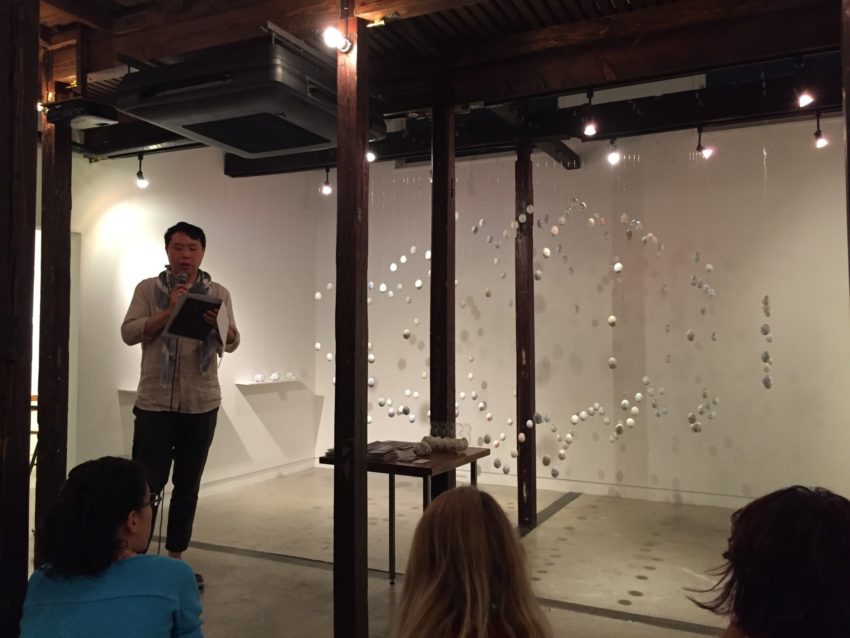Arthur Huang: Memory Walks -Is This the Way I Went?

Arthur Huang is another foreign resident in Tokyo and runs the Art Bytes Critique (ABC) group, of which I have recently joined. He has been exploring memory and its fragility by remembering his daily commute and then drawing it on eggs.
At Hagiso in the Hagi-Art space from May 17, 2016 to June 5, 2016, Huang had a show entitled Arthur Huang: Memory Walks – Is This the Way I Went? and he worked full-time and attended the gallery. The brief said:
Arthur Huang’s exhibition “Memory Walks – Is This The Way I Went?” explores the nature of our everyday memories. We tend to recall special events in our lives easily, but the memories of our everyday lives are not often recalled and likely forgotten. In both cases, our memories are never fixed and constantly changing.
In the October 2013 HAGISO group exhibition “Tokyo Spidering”, Arthur Huang began exploring ways of remembering his everyday walks through drawing on eggshells. For “Is This The Way I Went?” Huang continues that exploration by expanding the ways he imagines how those memories are recalled. For this exhibition of all new works, he will create an installation with six months of Memory Walk eggshells to resemble a brain occupying the HAGI-ART space. Since memories of everyday walks become fractured, confused, and forgotten over time, Huang will also be exhibiting new works using broken eggshells, eggshells that have been painted and layered, and eggshells that have been erased by drilling. These techniques examine metaphors for how memories are a synthesis of fragments from the past and present rather than actual memories of those moments.
本展「散歩記憶力 – この道で行きましたか?」は、アーサー・ファンが日常の記憶の本質を探求しています。
我々にとって、ある特別な出来事は容易に思い出すことが出来ますが、日常生活の記憶は思い出しにくく忘れやすいものです。
しかしどちらの場合も、思い出というものは常に変化をし、記憶が定着することはありません。
2013年10月にHAGISOで開催したグループ展「東京クローラ」において、アーサー・ファンは卵の殻を用いて散歩にまつわる記憶の方法について探求し始めました。本展の作品のために、彼は記憶のメカニズムを考え、新しい方法を探り続けてきました。
本展で発表する新作のインスタレーションでは、自らの6か月分の散歩を思い出し、卵の殻にドローイングをしたものを脳の形にインストールします。アーサー・ファンは自分の記憶をたどるため、様々な手法によって卵の殻に描いています。卵の表面に現れた軌跡は、記憶というのは如何にあいまいか、そしてそれらが現在と過去の断片からの合成であることを表現しています。
Hagiso even created special food tie-ins that they sold in their cafe during the exhibition period: a mini egg-salad sandwich and boiled eggs with keema curry between the two halves.
Yes, you probably have seen his work on this blog before. He has been in several group shows before, including one at Hagiso, the Tokyo Art Book Fair, and in Kojimachi, but this was his first solo show in Tokyo. You might have been wondering what exactly he draws on those eggs. I will let you in on his secret code.
As you can see, each mark has a meaning. The train lines are also coded by the colour used on the maps in Tokyo.
He also has a little plane to indicate when he is on a plane, but that is not written on the card. In the photo you can see the plane. As you can see by the lack of colour, he did not take any trains that day.
Huang shared his code with visitors and had a workshop where people could draw on their own eggshell, supplied by Huang.
Huang also had eggs on hand that visitors could hold in their hands, because human nature is to touch anything of interest.
Huang did not randomly hang the eggs: the eggs were hung in the same pattern as if you viewed a cross-section of a brain. He works as a neuroscientist at the RIKEN Brain Science Institute. (A clearer photo of the shape is included later in this post. Scroll down and you can see it.)
When helping to install the eggs, we were constantly on ladders looking down on the eggs. I admit that after a while I felt like a god with the fate of several worlds in my control. I could decide if they were hung safely in space or if they crashed. When crawling on the floor to clean up stray bits of string or wire, I had that same feeling when I looked up at the eggs (see above photo).
Eggs are fragile, so everybody, of course, wants to know what happens when one breaks. Huang uses the fragments to create sculptures and on the covers of art books that are available for sale.
Memory, being what it is, is easily lost. Huang went back and started erasing the memories of special days, such as his birthdays. I think he used correction fluid and sandpaper on these…
He did something similar with the eggs that recorded his daily commutes. This time, however, I think he used a Dremel router to carefully grind bits of shell away to erase his memories in the same way we forget them.
Huang also gave an artist talk in Japanese at the gallery. (Here you can clearly see the shape of the installation.) He also did a presentation at Pechakucha – Tokyo. His 20 slides can be seen on their website.
Aside from his amazing work ethic, I am impressed how he took what seems like a simple idea and developed it into several projects in various mediums. He has used this concept of fragile memory in drawings, installations, solo and group shows, photographs, art books, and prints. He has drawn and he has erased. He continues to explore various aspects of memory with this common household item, an egg. With his limited amount of time and enviable time-management skills, he shows what can be done when you sit down and do the work one step at a time. And he is one of the nicest guys you could ever meet!


















Never would have thought of this. The idea is fascinating, but the medium does not appeal to me.
Very cool idea. There are times when I wish I lived closer to Tokyo!
Between me and the alternative theatres, you would be a very busy woman.